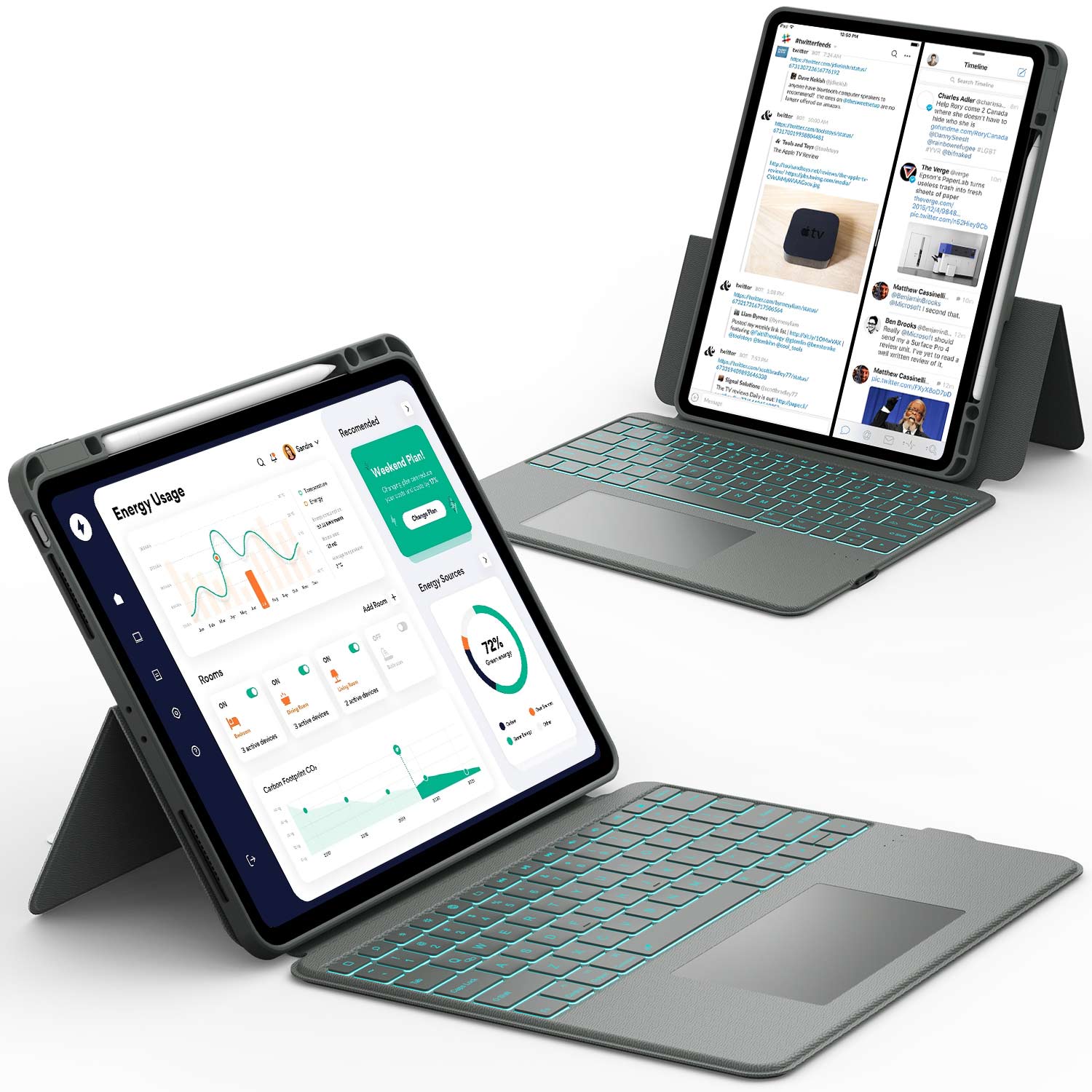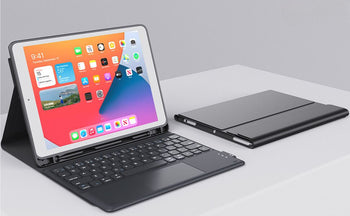In today's world, screens are everywhere, and that includes our kids' lives. Tablets, phones, and computers have become a huge part of daily routines. But too much screen time can cause problems for children, like trouble sleeping, bad grades, and even addiction. As a parent, it's really important to keep an eye on how much time your child spends on screens and help them cut back if needed. This article will talk about how to tell if your child is spending too much time on their iPad and what you can do about it.
Key Takeaways
- Recognizing when a child is spending too much time on their iPad is the first step to helping them.
- Setting clear limits on iPad use can help kids learn balance.
- Encouraging other fun activities helps kids find new interests beyond screens.
- Parents can show good screen habits themselves to teach their kids.
- Talking openly about screen use helps kids understand why limits are important.
Recognizing Signs of iPad Addiction in Children

It's easy to let kids use iPads for hours, especially when you need a break. But how do you know if it's gone too far? Recognizing the signs early is super important. It's not always obvious, but there are definitely things to watch out for. It's not about being a helicopter parent, but more about being aware and proactive.
Excessive Time on Devices
One of the first things to notice is how much time your child spends glued to their iPad. Is it just a couple of hours on weekends, or are they on it from the moment they wake up until bedtime? If screen time is consistently cutting into other important activities, that's a red flag. It's more than just liking the iPad; it's about needing it.
Consider these questions:
- Does your child choose the iPad over playing with friends?
- Are they missing meals or other important activities because they're on the iPad?
- Do they sneak extra time on the iPad when you're not looking?
Behavioral Changes When Denied Access
Pay attention to how your child reacts when you try to take the iPad away. Does a simple request turn into a full-blown meltdown? Do they get unusually angry, anxious, or even just really, really upset? These kinds of reactions can be a sign that they're overly dependent on the device. It's like they're going through withdrawal. It's not normal for a kid to throw a tantrum just because you asked them to put down a device for a few minutes.
Impact on Sleep and Academics
Is your child having trouble sleeping? Are their grades slipping? Too much screen time can mess with sleep patterns and make it hard to focus on schoolwork. The blue light emitted from screens can interfere with melatonin production, making it harder to fall asleep. Plus, if they're spending all their time on the iPad, they're not doing homework or studying. It's a recipe for academic trouble.
It's important to remember that every child is different, and what might be a sign of addiction in one child might not be in another. The key is to look for patterns of behavior and to trust your instincts. If you're concerned, talk to your child's doctor or a therapist.
Establishing Clear Screen Time Boundaries

Okay, so this is a big one. It's not just about saying "no more iPad!" It's about finding a balance that works for your kid and your family. It's about teaching them self-control, not just blindly banning devices. It can be tough, but trust me, it's worth it. Think of it like teaching them to eat their vegetables – they might not love it at first, but it's good for them in the long run.
Setting Daily Time Limits
Want to make your child’s iPad time more productive? The CHESONA Keyboard Case for iPad turns their tablet into a study-friendly tool, perfect for schoolwork during those allowed screen hours. With a comfortable keyboard and precise trackpad, it’s great for typing assignments or researching projects, while the durable case keeps their iPad safe.
The first step is to figure out how much screen time is appropriate for your child's age and needs. This isn't a one-size-fits-all thing. A teenager might need more screen time for homework than a younger child. Consider their schoolwork, extracurricular activities, and sleep schedule when setting limits. It's also a good idea to differentiate between recreational use and educational use. Maybe they get an hour for games, but extra time for research or educational apps. Here's a simple example:
- Weekdays: 1 hour of recreational screen time
- Weekends: 2 hours of recreational screen time
- Educational use: Unlimited (with supervision)
Creating Screen-Free Zones and Times
This is all about creating boundaries. Designate certain times and places as completely screen-free. This could be during meals, before bedtime, or in certain rooms of the house. The goal is to create opportunities for face-to-face interaction and other activities. It's about being present and fostering connections without the distraction of screens. For example:
- No screens at the dinner table.
- No screens in the bedroom one hour before bedtime.
- Family game night is a screen-free zone.
Creating device-free times helps kids (and adults!) disconnect and engage in the real world. It's about being present and fostering connections without the distraction of screens.
Implementing Consistent Rules
Consistency is key. Once you've set the rules, stick to them. This means enforcing the limits even when it's inconvenient or when your child protests. It's also important to be a good role model. If you're constantly on your phone, it's going to be hard to convince your child to limit their screen time. Post the rules somewhere visible, like on the fridge. This helps avoid constant negotiations and arguments. It's also important to remember that rules are not set in stone. As your child grows and their needs change, you may need to adjust the limits. The important thing is to communicate openly and involve them in the process. This can help prevent sleep disturbances that can come from feeling controlled.
Utilizing Parental Control Features
Okay, so you're trying to get a handle on your kid's iPad use, and you've tried talking, setting timers, and maybe even hiding the charger (we've all been there, right?). But sometimes, you need a little extra help. That's where parental control features come in. They're not a magic bullet, but they can be a pretty useful tool in your arsenal.
Leveraging Built-In Device Controls
Both iOS and Android devices have built-in parental controls that can help you manage screen time. Explore these features to set time limits, restrict access to certain apps, and monitor usage. These tools can be surprisingly effective. For instance, you can set a daily time limit for gaming apps or block access to social media during school hours. It's all about finding what works best for your family and using the technology to your advantage.
Parental controls are a great way to keep your child’s iPad use in check, but why not boost its learning potential too? The CHESONA Keyboard Case adds a responsive keyboard and trackpad, making it easier for kids to tackle homework or explore educational apps under your supervision. Its long-lasting battery and protective design ensure safe, focused use.
Monitoring Device Usage with Apps
These apps let you see exactly what your kids are doing on their iPads. Which apps they use the most, which websites they visit, and how much time they spend on each. It's like having a little window into their digital world. This can be super helpful for understanding their habits and spotting any potential problems early on. For example, if you notice your child is spending hours on a social media app you've never heard of, you can look into it and see if it's age-appropriate. You can use parental control apps to filter content.
Blocking Inappropriate Content
One of the best things about parental control features is the ability to filter content. You can block certain websites, apps, or even entire categories of content. This is especially useful for younger kids who might accidentally stumble upon something they shouldn't see. Most apps let you customize the filters based on your child's age and maturity level. It's not foolproof, but it adds an extra layer of protection.
Parental control features aren't about being a helicopter parent. They're about giving you the tools you need to help your kids develop healthy digital habits. It's about finding a balance between letting them explore and keeping them safe.
Encouraging Alternative Activities and Interests
It's easy for kids to get stuck in a cycle of iPad use, but the good news is there are tons of other things they can enjoy! The key is to help them discover new interests and activities that are just as, or even more, engaging. It's not about forcing them into anything, but about opening doors to new possibilities. Let's explore some ways to do that.
Promoting Outdoor Play and Physical Activity
Getting kids outside is a fantastic way to reduce their reliance on iPads. Outdoor play offers a ton of benefits, from physical health to improved mood. Think about what your child likes to do. Do they enjoy riding bikes, playing sports, or just exploring nature?
- Organize family hikes
- Bike rides
- Trips to the park
Even simple activities like playing tag in the backyard can make a big difference. Consider signing them up for a sports team or a local recreation program to encourage regular physical activity and social interaction.
Fostering Creative Hobbies and Crafts
Encourage your child to explore different hobbies and creative activities. This could include anything from painting and drawing to playing a musical instrument or building models. The goal is to find something that captures their attention and allows them to express themselves. Provide them with the necessary materials and resources, and let them experiment. Maybe they'd enjoy joining a coding club, learning a new language, or writing stories. The possibilities are endless, and you might be surprised at what they discover.
Encouraging Reading and Board Games
Reading and board games are awesome alternatives to screen time. They stimulate the mind, encourage critical thinking, and can be a lot of fun! Make reading a regular part of your child's routine. Visit the library together and let them choose books that interest them. As for board games, there are so many options out there, from classic games like Monopoly and Scrabble to newer, more strategic games. Family game night can become a cherished tradition, creating lasting memories and strengthening bonds.
It's important to remember that finding the right alternative activities may take some time and experimentation. Be patient and supportive, and let your child lead the way. The goal is to help them discover new passions and interests that will enrich their lives beyond the screen.
Modeling Healthy Digital Habits

It's one thing to tell your kids to put down their iPads, but are you setting a good example? Kids notice everything, and they'll pick up on your habits, whether they're good or bad. If you're always on your phone, it sends a mixed message. Leading by example is key here. It's not about being perfect, but about showing them you're making an effort to find a healthy balance.
Practicing Mindful Device Use
It's not just how much time you spend on screens, but how you spend it. Are you mindlessly scrolling, or are you using technology intentionally? Being aware of your own usage is the first step.
Here are some things you can try:
- Set specific times for checking email and social media, instead of doing it constantly.
- Be present during conversations, putting your phone away. This shows your kids that they have your full attention.
- Use technology for learning or creating, not just consuming. Maybe take an online course or try digital art.
Engaging in Family Activities Without Screens
It's easy to get caught up in the digital world, but it's important to remember the real world is still out there. We need to show our kids that there are plenty of fun and interesting things to do that don't involve screens. It's about finding that real-world engagement.
Here are some ideas:
- Plan family outings to parks, museums, or local events. Get everyone involved in choosing the activity.
- Encourage hobbies like reading, painting, or playing sports. Support their interests, even if they're not your own.
- Schedule regular family game nights or movie nights (yes, even movies can be real-world engagement!). Make it a tradition that everyone looks forward to.
It's not about demonizing technology; it's about finding a healthy balance. By modeling good digital habits, we can help our kids develop a positive relationship with technology and learn to use it in a way that enhances their lives, rather than detracts from them.
Discussing Digital Well-being Openly
Instead of just setting rules, explain why. Talk about how too much screen time can affect sleep, focus, and even mood. Use age-appropriate language and examples they can relate to. For younger kids, you might talk about how it takes away from playtime with friends. For older kids, you could discuss the impact on their grades or social life. It's also important to acknowledge the benefits of technology, like learning and connecting with others, to show that you're not completely against screens. It's about modeling healthy screen habits.
Communicating Openly About Screen Use

It's easy to fall into the trap of just setting rules and expecting kids to follow them, but that rarely works. A better approach is to talk openly about screen use. This means creating a safe space where kids feel comfortable sharing their thoughts and feelings without judgment. It's about collaboration, not just dictation.
Explaining the 'Why' Behind Limits
Instead of just saying "screens are bad," explain why. Talk about how too much screen time can affect sleep disturbances, focus, and even mood. Use age-appropriate language and examples they can relate to. For younger kids, you might talk about how it takes away from playtime with friends. For older kids, you could discuss the impact on their grades or social life. It's also important to acknowledge the benefits of technology, like learning and connecting with others, to show that you're not completely against screens.
Involving Children in Rule-Setting
Kids are more likely to follow rules they helped create. Instead of imposing strict limits, involve them in the process. Ask them how much screen time they think is reasonable and what times of day are best for them. You might be surprised by their answers! This approach gives them a sense of ownership and responsibility. Negotiate and compromise to find a balance that works for everyone. Remember, the goal is to teach them self-regulation, not just blind obedience. This can also help prevent social isolation that can come from feeling controlled.
Addressing Resistance and Frustration
It's inevitable that kids will push back against screen time limits at some point. When this happens, try to understand their perspective. Are they feeling bored, left out, or like they're missing out on something? Acknowledge their feelings and validate their concerns. Instead of getting angry or defensive, try to find a compromise or alternative solution. Maybe they can earn extra screen time by completing chores or homework, or maybe you can find a fun activity to do together that doesn't involve screens. The key is to model healthy screen habits and show them that you're willing to work with them to find a solution that works for everyone.
It's important to remember that finding the right alternative activities may take some time and experimentation. Be patient and supportive, and let your child lead the way. The goal is to help them discover new passions and interests that will enrich their lives beyond the screen.
Wrapping Things Up
So, there you have it. Helping your kids have a healthy relationship with their iPad isn't always easy, but it's totally doable. It's not about getting rid of screens completely; it's about finding a good balance. Remember, you're the parent, and you set the rules. Be firm, be consistent, and try to make screen time just one part of a fun, well-rounded childhood. You've got this!
Helping your child balance iPad use is all about making screens work for them, not against them. The CHESONA Keyboard Case for iPad transforms their tablet into a powerful tool for learning, with a backlit keyboard, adjustable stand, and rugged case to keep it safe.
Frequently Asked Questions
How can I tell if my child is spending too much time on their iPad?
Keep an eye out for a few things. If your child is spending a lot of time on their device, gets really upset when you ask them to stop, has trouble sleeping, or if their school grades start to drop, these could be signs of too much screen time. They might also start to ignore friends or family because they're always on their iPad.
What are some easy ways to limit my child's iPad use?
A great first step is to set clear rules. Decide on specific times your child can use their iPad and for how long. Make sure there are times when no one uses screens, like during meals or before bed. You can also use the settings built into the iPad to help control how much they use it.
What can I do to get my child interested in things other than their iPad?
Encourage your child to try new things! Suggest playing outside, doing arts and crafts, reading books, or playing board games. Help them find hobbies that don't involve screens, and make sure they spend time with friends face-to-face.
Should I also change my own screen habits to help my child?
Absolutely! Kids often copy what they see. So, try to use your own devices wisely. Don't be on your phone all the time, especially when you're with your family. Show them that there's a good balance between screen time and other activities.
Is it important to keep iPads out of my child's bedroom?
Yes, it's a good idea to keep iPads out of bedrooms. This can help them sleep better and reduce the urge to use devices late at night. Also, try to have some areas in your home where no one uses screens, like the dining room.
Are there any apps that can help me manage my child's iPad time?
Many apps can help! These apps let you see how much time your child spends on their iPad, block certain websites, and set time limits for games or social media. Also, check out the parental control features that come with your child's device.
















